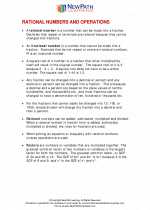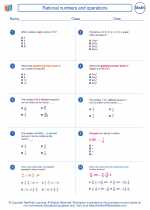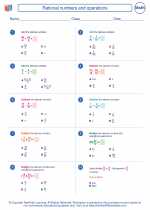Divisor
In mathematics, a divisor of a number is any number that divides the original number without leaving a remainder. For example, the divisors of 12 are 1, 2, 3, 4, 6, and 12 because each of these numbers divides 12 without leaving a remainder.
Finding Divisors
To find the divisors of a number, you can start by dividing the number by 1 and then continue dividing by consecutive numbers up to the number itself. If the division results in a remainder of 0, then the divisor is found.
Example
Let's find the divisors of 24:
24 ÷ 1 = 24 (remainder 0) - 1 is a divisor
24 ÷ 2 = 12 (remainder 0) - 2 is a divisor
24 ÷ 3 = 8 (remainder 0) - 3 is a divisor
24 ÷ 4 = 6 (remainder 0) - 4 is a divisor
24 ÷ 5 = 4 (remainder 4) - 5 is not a divisor
24 ÷ 6 = 4 (remainder 0) - 6 is a divisor
24 ÷ 7 = 3 (remainder 3) - 7 is not a divisor
24 ÷ 8 = 3 (remainder 0) - 8 is a divisor
24 ÷ 9 = 2 (remainder 6) - 9 is not a divisor
24 ÷ 10 = 2 (remainder 4) - 10 is not a divisor
24 ÷ 11 = 2 (remainder 2) - 11 is not a divisor
24 ÷ 12 = 2 (remainder 0) - 12 is a divisor
Properties of Divisors
Every number has at least two divisors: 1 and itself. These are called the trivial divisors. For example, the divisors of 7 are 1 and 7, and the divisors of 13 are 1 and 13.
The number 1 has only one divisor, which is itself.
If a number has an odd number of divisors, it is a perfect square. For example, the number 16 has 5 divisors (1, 2, 4, 8, 16), which is odd, and 16 is a perfect square (4 * 4).
If a number has an even number of divisors, it is not a perfect square.
Study Guide
Here are a few key points to remember about divisors:
- A divisor of a number divides it without leaving a remainder.
- Every number has at least two divisors: 1 and itself.
- To find divisors, divide the number by consecutive integers up to the number itself and check for remainders.
- A number with an odd number of divisors is a perfect square.
- A number with an even number of divisors is not a perfect square.
Understanding divisors is important in various mathematical operations, such as factorization, simplifying fractions, and finding common factors.
Feel free to practice finding divisors of different numbers to solidify your understanding of this concept!
.◂Math Worksheets and Study Guides Eighth Grade. Rational numbers and operations

 Worksheet/Answer key
Worksheet/Answer key
 Worksheet/Answer key
Worksheet/Answer key
 Worksheet/Answer key
Worksheet/Answer key
